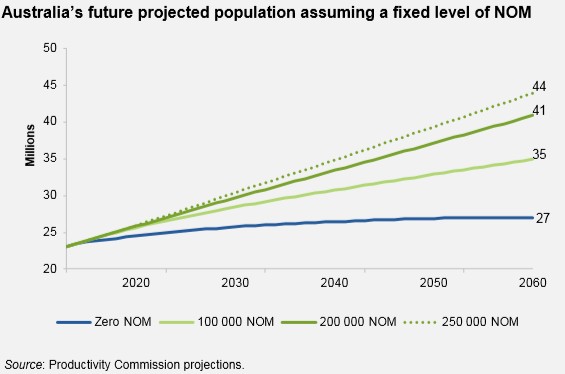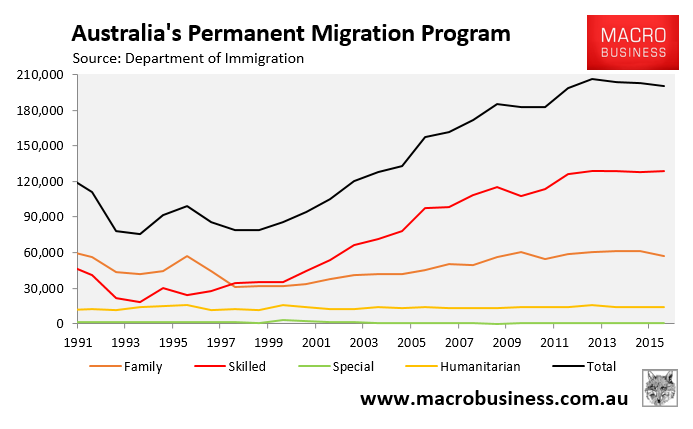Late last year, it was revealed that Australia’s carbon emissions are on the rise and the nation is on track to badly miss the scientifically based targets set by the government’s Climate Change Authority, as well as those under the Paris agreement.
Then in July, the federal government released data showing that Australia’s greenhouse gas emissions have continued to grow, broadly matching Australia’s population growth.
Last month, the UN Environment Program’s Emissions Gap 2017 report found that Australia’s emissions will “far exceed” the 2030 Paris pledge:

Now, new Environment Department figures show Australia’s greenhouse gas emissions increased for the third consecutive year in 2016-17, shattering its emission reduction targets. From The ABC:
…gas emissions grew by 0.7 per cent last financial year, which has been blamed on an increase in gas production and exports.
That comes after a 0.8 per cent increase during the 2015/16 financial year, which was accompanied with a warning Australia was not on track to meet its 2030 emissions reduction target.
But Energy Minister Josh Frydenberg said the latest data showed the Federal Government was expected to achieve its 2020 climate change target reduction of 294 million tonnes compared to 2000 levels.
In a statement, Mr Frydenberg said Australia was, “[continuing] to close the gap on the 2030 target” despite the annual increase in gas emissions.
“Australia beat its first Kyoto Protocol target by 128 million tonnes of emissions, and updated data released today by the Department of Environment and Energy shows Australia’s emissions are now at their lowest level in 28 years on a per capita and GDP basis,” Mr Frydenberg said…
Climate Council chief executive Amanda Mackenzie said the latest figures showed Australia risked becoming, “the global climate laggard”.
“The consequences of worsening climate change have already been seen across Australia in 2017 alone, in the form of intensifying extreme weather events including supercharged storms, heatwaves and bushfires, along with the repeated bleaching of the Great Barrier Reef,” Ms Mackenzie said.
While Australia’s emissions depend on many factors – including our energy use patterns, exports, and how we live – nobody can deny the fact that Australia’s high population growth (immigration) policy will make it next to impossible to meet our targets nor safeguard Australia’s environment.
As shown in the next chart, which comes from the Productivity Commission, Australia’s population will reach more than 40 million mid-century under current immigration settings, at least 13 million more than what would occur under zero net overseas migration (NOM):

That’s a helluva lot of extra people consuming resources and emitting greenhouse gasses. It also means that Australia would need to cut its per capita emissions by around two-thirds just to keep total emissions at current levels (other things equal), let alone reduce them.
But don’t just take my word for it. In May last year, a University of Adelaide-led study entitled Implications of Australia’s Population Policy for Future Greenhouse Gas Emissions Targets noted the direct (obvious) link between population size, emissions and environmental degredation:
It is clear from our demographic modelling and the available data on net overseas migrants that Australia’s future population is entirely contingent on its immigration policies… The current demographic state of the Australian population is such that if all net immigration were halted today, the population would stabilize by the mid-2040s and decline only slightly thereafter, achieving nearly the same population size that it is today by mid-century…
Whether Australians choose to limit their future population growth is entirely another matter. The country’s natural systems have already suffered severe degradation of ecosystems…
In this context, any policy that seeks an even larger Australian population would need to be carefully focused on how to achieve this goal sustainably, while mitigating (and, in some situations, reversing) these threatening processes. Given the rising environmental damage globally from a large and growing human population (Bradshaw & Brook 2014), Australia has the rare option to limit this damage by adjusting its immigration policies accordingly…
Based on current population policies, the projected growth in the Australian population will make its already challenging future emissions-reduction goals even more difficult to achieve. In addition to the rising pressure of Australia’s population on its ecosystems, the country’s future greenhouse gas emissions are also partially tied to its immigration policy…
With a 2020 target of 5 per cent reduction in emissions (relative to 2000), a 27 per cent reduction by 2030 (relative to 2005) and potentially an 80 per cent reduction by 2050, Australia has no credible mechanisms in place to achieve these goals… it seems unlikely that Australia will be able to achieve either of these two targets without substantial policy changes across population, energy, agriculture and environmental sectors.
Given that Australia has less than 14 years to meet the 2030 target, and less than 34 years to meet the putative 2050 target, and that a reduction in per capita emissions of 83.5 per cent would still be required even under the extreme scenario of no net migration…
Irrespective of these challenges, any increase in Australia’s population will make these targets even more difficult, such that a business-as-usual projection (scenario 1) would require a fivefold greater reduction in per capita emissions to reach a 2050 target of 80 per cent reduction compared with the zero-immigration scenario and produce ~10 per cent more emissions…
More population growth driven by immigration will hamper Australia’s ability to meet its future climate change mitigation commitments and worsen its already stressed ecosystems, unless a massive technological transformation of Australia’s energy sector is immediately forthcoming.
And let’s not forget that it’s not just Australia’s emissions that are being made worse via never-ending mass immigration, but also the destruction of Australia’s natural habitat. Let’s recall what the latest federal government State of the Environment report said on the matter, via The Conversation:
Australia’s population growth and economic activity continue to pose major environmental challenges, according to a comprehensive five-yearly stocktake of the country’s environmental health.
The federal government’s State of the Environment 2016 report (prepared by a group of independent experts, which I chaired), released today, predicts that population growth and economic development will be the main drivers of environmental problems such as land-use change, habitat destruction, invasive species, and climate change…
We continue to lose agricultural lands through urban encroachment. Over the past five years land-clearing rates stabilised in all states and territories except Queensland, where the rate of clearing increased.
Coastal waterways are threatened by pollutants, including microplastics and nanoparticles…
Population growth in our major cities, along with Australia’s reliance on private cars, is leading to greater traffic volumes, which increase traffic congestion and delays as well as pollution…
Australia needs to support the Paris Agreement on emissions reduction if it expects other nations to do so. Yet population growth is clearly threatening our ability to do so.
Again I ask: why are the Australian Greens conspicuously silent about Australia’s mass immigration program? Why won’t they lobby to slash Australia’s non-humanitarian intake (currently 190,000 per year) by at least two-thirds while doubling Australia’s tiny humanitarian program (currently around 13,000)?

This way, The Greens can achieve they social justice goals while also safeguarding Australia’s environment.

